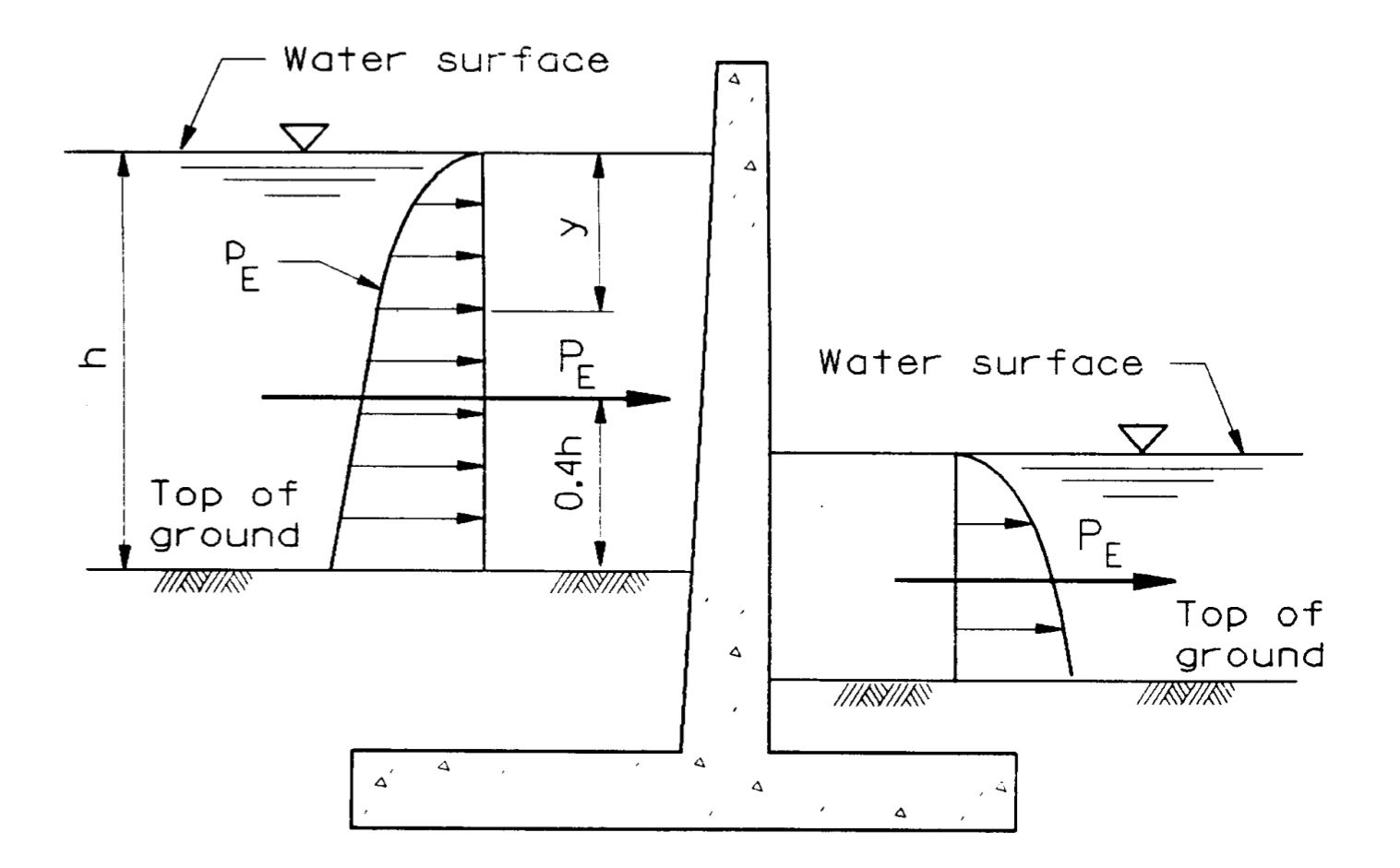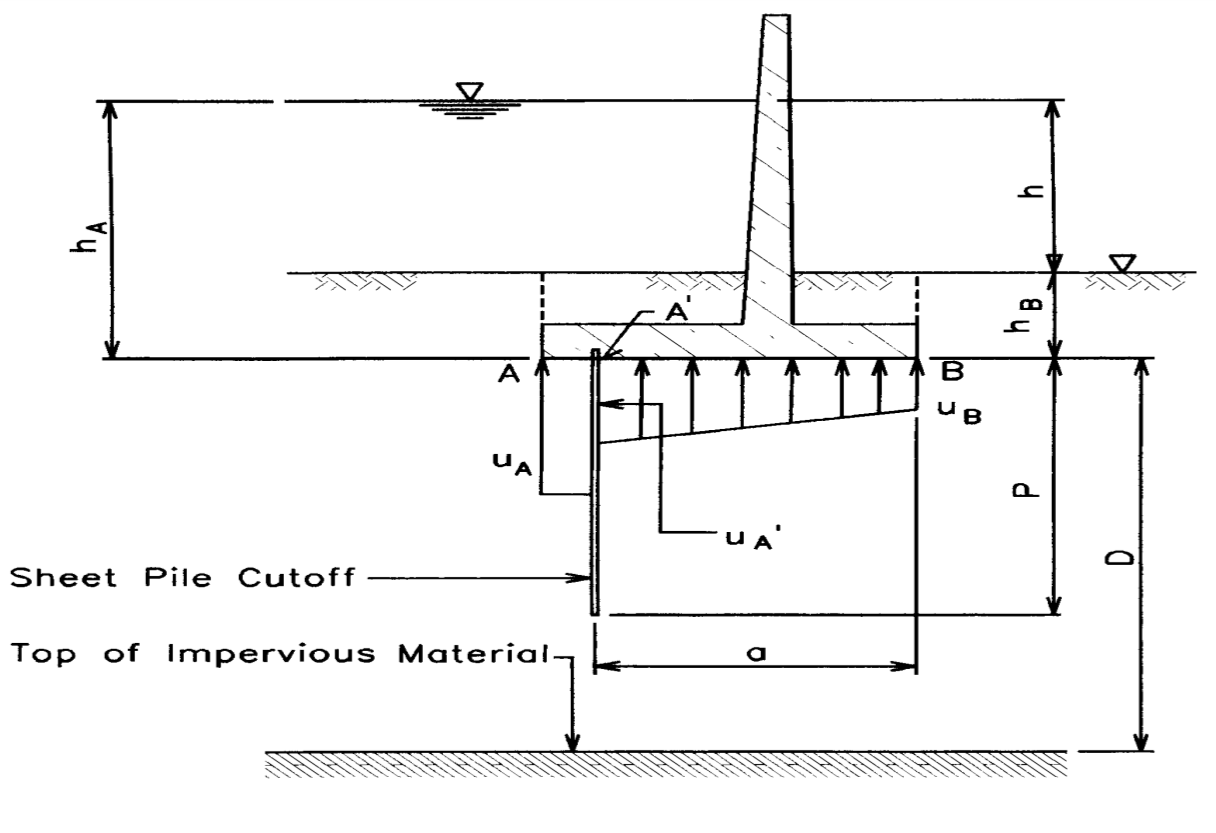| 1. |
The objective of a stability analysis is to maintain horizontal, vertical, and rotational equilibrium of the structure. What are the factors that are to be provided to ensure stability?
|
|
|
Providing an adequate factor of safety against sliding at all possible failure planes. |
|
|
Providing specific limitations on the magnitude of the foundation bearing pressure. |
|
|
Providing constraints on the permissible location of the resultant force on any plane. |
|
|
Providing an adequate factor of safety against flotation of the structure. |
|
|
All of the above. |
| 2. |
This mode of failure occurs when the net uplift force (gross uplift on the base minus the weight of surcharge water above the structure) exceeds the summation of forces due to the weight of the structure, the weight of water contained in the structure, and other surcharge loads. This type of failure is called as |
|
|
Sliding planes |
|
|
Flotation |
| 3. |
The allowable bearing capacity is defined as the maximum pressure that can be permitted on a foundation soil or rock mass giving consideration to all pertinent factors, with adequate safety against rupture of the soil or rock mass, or settlement of the foundation of such magnitude as to jeopardize the performance and safety of the structure. |
|
|
True |
|
|
False |
| 4. |
To qualify as well-defined site information, it must satisfy the following requirements:
- Available records of construction, operation, and maintenance indicate the structure has met all performance objectives for the load conditions experienced.
- Foundation strengths can be established with a high level of confidence.
- The governing load conditions can be established with a high level of confidence.
- Uplift pressures for design load conditions are known, or can be extrapolated for design load conditions based on measured uplift pressure data.
|
|
|
True |
|
|
False |
| 5. |
Civil works structures, for the purpose of establishing safety factors or safety provisions for use in stability analyses, are to be designated as either critical or normal. Structures designated as critical are those structures on high hazard projects whose failure will result in loss of life.
|
|
|
True |
|
|
False |
| 6. |
The factor of safety for sliding is defined by
(Refer chap 3; pg 3-4)

Where:
N =?
Ø = angle of internal friction of the foundation material under the structural wedge.
c = cohesive strength of the foundation material under the structural wedge.
L = length of the structural wedge in contact with the foundation.
T = shear force acting parallel to the base of the structural wedge.
What does N mean?
|
|
|
Force acting normal to the sliding failure plane under the structural wedge. |
|
|
Uplift forces acting on the base of the structure. |
|
|
None of the above. |
| 7. |
The maximum design flood (MDF) is the designation used to represent the maximum structural loading condition (as judged by the minimum factor of safety) and must be determined for each structure or even for each structural element.
|
|
|
True |
|
|
False |
| 8. |

Figure 1.0
What does the figure 1.0 illustrate about? |
|
|
Hydrodynamic Forces for Freestanding Water |
|
|
Idealized earthquake loads |
|
|
Stability analysis of a structure |
|
|
None of the above
|
| 9. |
Uplift pressures shall be calculated based on an approximate seepage analysis and shall be applied over the full area of the base of the structure, or the failure plane under investigation. |
|
|
True |
|
|
False |
| 10. |
Two-dimensional stability analyses using traditional methods are suitable for the intermediate monoliths of structures that have uniform geometry and loading for their entire length and where the loads and resistance due to end effects are not transmitted across monolith joints. |
|
|
True |
|
|
False |
| 11. |
Unlike a gravity dam, where stability is provided by the weight of the structural wedge, an arch dam’s stability depends, not only on weight but also to a much larger extent, upon arch action that transmits the imposed loads to the valley walls.
|
|
|
True |
|
|
False |
| 12. |
Finite element methods can be used to determine the manner in which loads and resistance are developed as a function of the stiffness of the foundation, stiffness of the structure, and the structure-to-foundation interface. They can also be used to calculate displacements and stresses due to incremental construction and/or load applications, and can model nonlinear stress-strain material behavior. |
|
|
True |
|
|
False |
| 13. |
Preliminary analysis should be performed based upon available data and actual conditions of the structure. Before performing the analysis, collect and review all the available data and information for the structure including geologic and foundation data, design plans, as-built plans, periodic inspection reports, damage reports, plans of previous modifications to the structure, measurements of movement, instrumentation data, and other pertinent information. |
|
|
True |
|
|
False |
| 14. |
If the stability of the structure is still in question after completing preliminary and comprehensive analyses, advanced analytical studies should be performed. These studies should use two- and three-dimensional finite element methods to capture the interaction between the foundation, backfill, and the structure, and to capture the capacity of the structural system to distribute loads to adjacent monoliths and abutments. |
|
|
True |
|
|
False |
| 15. |
Stability can be improved through several means such as by the use of foundation drains to reduce uplift, by adding anchors, and by adding concrete mass, concrete buttresses, or buttressing embankments. |
|
|
True |
|
|
False |
| 16. |
Drainage is an effective means of reducing uplift pressures for structures founded on rock. It also is effective for structures founded on soils, provided the loss of soil materials through piping can be prevented. |
|
|
True |
|
|
False |
| 17. |

Figure 2.0
What does Figure 2.0 say about? |
|
|
Uplift pressures with sheet pile cutoff |
|
|
Stilling basin with discharge condition |
|
|
Active earth pressure diagrams |
|
|
None of the above |
| 18. |
What are the assumptions made by the Mononobe-Okabe analysis?
|
|
|
The structure is free to yield sufficiently to enable full soil strength or active pressure conditions to be mobilized. |
|
|
The backfill is completely above or completely below the water table, unless the top surface is horizontal, in which case the backfill can be partially saturated. |
|
|
The backfill is cohesionless. |
|
|
The top surface is planar (not irregular or broken). |
|
|
Any surcharge is uniform and covers the entire surface of the soil wedge. |
|
|
Liquefaction is not a problem. |
|
|
All of the above |
| 19. |
The equations for determining the critical slip-plane angle for driving and resisting wedges subjected to a horizontal acceleration are developed with the following assumptions: |
|
|
The shear on the vertical face of the wedge is zero. |
|
|
The shear strength along the potential slip planes in the soil has not been mobilized to any extent, i.e., for static loading prior to an earthquake. |
|
|
Both 1&2 |
|
|
None of the above |
| 20. |
When structures are located in areas of high seismicity, earthquake effects must be considered in the failure scenario investigation. Earthquake effects include ground motion demands, fault displacements, subsidence, slope instability, and liquefaction. |
|
|
True |
|
|
False |
|